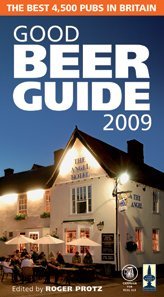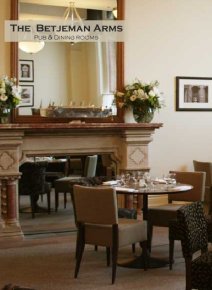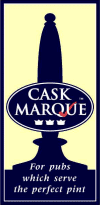| |
This article was first published in the Independent newspaper, September 2008
The British pub is alive and well
by Willard Clarke, 10/08
The British pub is alive and well: that's a claim that should cause the men in white coats to cart me off for a period of quiet contemplation in a padded cell. It's common knowledge that the pub is finished, heading for the great saloon bar in the sky. Battered by the smoking ban, fast food outlets and the attractions of watching multi-channel television from the comfort of your couch with a four-pack of supermarket lager, is it any wonder that the average pub is as empty as a ministerial promise.
Last Saturday the Independent newspaper devoted a second leader to the decline of the great British boozer. Too much loud music and lousy beer quality was the charge.
| The editor tells me he has to drive half way across London to find a pub serving a decent pint. But he will find in the new edition of the Good Beer Guide not only some 280 pubs serving great beer in London, but thousands more throughout the country pulling pints of cask ale of the highest quality. These pubs are supplied by a growing army of small craft breweries that have combined to give Britain the greatest choice in beer it has enjoyed for 30 years or more.
I'm aware of the statistics: 36 pubs close every week. The reasons are not hard to find. First came the smoking ban. As a non-smoker, I'm delighted to walk into a pub and no longer be assailed by the noxious odour of stale cigarette smoke. But the government handled the change insensitively. As the Campaign for Real (Camra) and other organisations argued, pubs with more than one bar should have been allowed to set aside an indoor area for smokers, with a date set for a complete ban on smoking in pubs within an agreed number of years. The result of the total lockout for smokers has been to drive them into the arms of the supermarkets, with a drastic decline in the numbers attending pubs.
|
|

|
Then came Hurricane Darling with a swingeing increase in excise duty on beer in this year's budget that has put 16-20 pence on the cost of a pub pint. In some parts of the country, a pint will set you back �2.80 to �3. The supermarkets, selling slabs of lager that retail at the equivalent of between 57 and 77 pence a pint, must have the chancellor high on their Christmas card list.
And yet it's not all unrelieved gloom in the pub trade. The evidence from the new Good Beer Guide is that publicans who do the basics well and avoid frills and gimmicks will still attract custom. Pubs today are no longer spit and sawdust offering a pint of mild and a pickled egg. If beer is not your tipple you will often find a good range of wine, food at affordable prices, a warm welcome and good service. But success, increasingly, is based on offering a wide variety of cask beers from the growing number of small craft breweries.
|
|
Take for example the Bricklayers Arms in Waterman Street, London SW15, a few yards from Putney Bridge. It closed as a result of drug-dealing and other unpleasantness. But former actress Becky Newman
rescued it in 2005 and revived it by concentrating on offering top quality real ale from a brewery not well represented in London: Timothy Taylor of Keighley in West Yorkshire.
Taylor's prize-winning premium bitter Landlord is available in the capital, but Becky installed the brewery's complete range, including an unfashionable Dark Mild. The result is a busy and successful pub.
|
Becky also offers four other cask beers from small craft breweries and stages regular beer festivals. Her greatest achievement has been to encourage football fans who use the pub after matches at Fulham FC to switch from lager to real ale.
The Bricklayers proves that it's beer that will save and drive the pub. There has been a quiet brewing revolution in Britain in recent years. While national and regional breweries have declined, smaller craft or micro producers have rushed to replace them. There are now around 550 craft breweries, more per head than any other country. Their owners have passion, commitment and a willingness to innovate. It was the craft brewing sector that first introduced golden ales to offer both a refreshing style for the summer and an attempt to win younger drinkers from lager to cask beer. As well as golden ales, the craft sector has also revived such once-famous British beer styles as porter, India Pale Ale, old ale and barley wine. There's more, far more, than just mild and bitter in the modern pub.
In 2007, the Society of Independent Brewers that represents most craft breweries reported that its members had achieved an average increase in sales of 11 per cent, at the same time as Stella Artois, the biggest-selling premium lager, had seen a 10 per cent fall in its sales. As craft brewers concentrate in the main on draught ale, pubs are their target audience and it's pubs offering a good range of ales that are prospering.
| Earlier this year, the revamped St Pancras station installed a pub, fittingly called the Betjeman Arms. It's spacious, modern, attracts mainly young people and serves restaurant quality food. The bar offers a wide range of keg beers, lagers and ciders but Ed Turner of Geronimo Inns, which owns the pub, told me that cask beer � Adnams, Fuller's and Sharp's from Cornwall � were the biggest sellers.
It's not only new breweries that are doing well. George Bateman & Son of Wainfleet, Lincolnshire, is a family company established in 1874 and owns an estate of 64 pubs. Managing director Stuart Bateman told the Good Beer Guide that 2007 was the brewery's most successful year in its long history. Profits were up, sales were up and cask beer grew by 10 per cent. This year, in spite of the smoking ban and the budget increase in duty, 21 of Bateman's pubs are showing �significant growth�. Bateman's installed a new brewhouse in 2002 that boosted annual volumes to 30,000 barrels but it needs to add new fermenting vessels to extend to 40,000.
|
|

|
Timothy Taylor celebrates 150 years of brewing this year, has invested �10 million in new equipment and has seen annual production double from 30,000 barrels to 60,000 in the past 20 years. Adnams in Southwold, Suffolk, has invested close to �10 million in a new brewhouse and warehouse complex, complete with energy-saving devices that trap steam and carbon dioxide. St Austell in Cornwall, with a substantial estate of 160 pubs, has grown from 15,000 barrels a year in 1998 to 45,000 barrels and is so keen on energy efficiency that managing director James Staughton has swapped his Mercedes for a Smart Car.
If craft breweries are not standing still, then neither are their pubs. When Camra and the Good Beer Guide were launched in the early 1970s, pubs were utilitarian places, shorn of creature comforts and appealing mainly to men. Food, at best, was a cheese sandwich, at worst a packet of pork scratchings. Today they offer real service, welcome women and families and, increasingly, good food at sensible prices. I'm not a fan of gastropubs that all too often cease to be pubs and turn into restaurants, with the handpumps thrown in the skip. Food should be an integral part of the pub, but should not overwhelm it.
Food should also be imaginative. With 55,000 pubs in all parts of the country, it's not difficult to source local food and create tasty and affordable dishes without the aid of a microwave. Reports show that, as a result of the credit crunch, people are forsaking expensive restaurants in droves while pubs, such as the Wetherspoon's chain, that offer unfussy and well-priced food are attracting new custom.
The key recipe for success is for publicans to remember that their pubs are at the heart of their communities. I'm struck by the number of the pubs in the Good Beer Guide that emphasise that role by staging small beer festivals, the ever-popular quiz nights, events that raise money for charities, and celebrations -- often with beers brewed specially for the occasion -- for Halloween, Bonfire Night, Christmas and New Year.

|
|
And, contrary to this paper's leader writer, beer quality has never been better (an industry-sponsored organisation called Cask Marque monitors cask beer and awards publicans) and not all pubs are full of hideous din. Many, including Wetherspoon's outlets, are free from music and there's a special symbol in the guide for quiet pubs.
My local has neither piped music nor television screens. If you fancy joining me in the King William IV in St Albans, that's me at the bar with an empty glass and a hopeful smile.
*Camra Good Beer Guide 2009, �14.99, from bookshops or from www.camra.org.uk.
go to part II: The 25 best pubs in Britain
|
|
|

